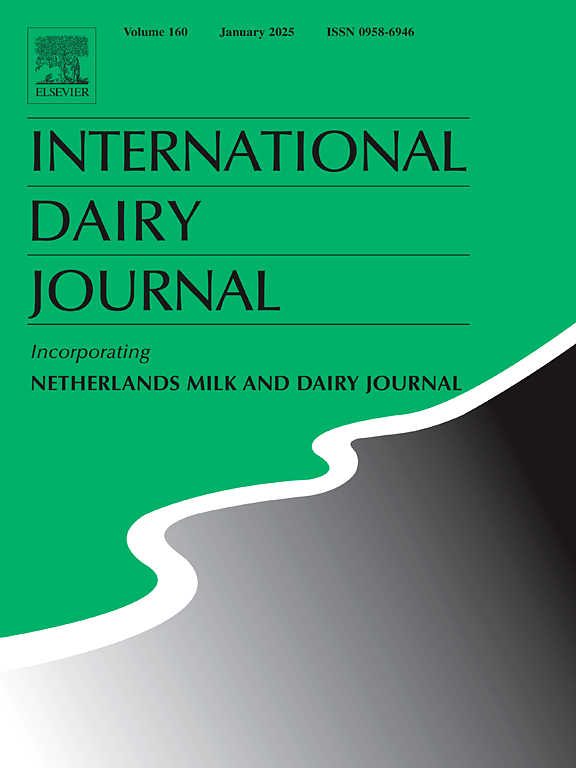Potential influence of the heat stress monitored along the production chain of Grana-type cheese manufacture
IF 3.4
3区 农林科学
Q2 FOOD SCIENCE & TECHNOLOGY
引用次数: 0
Abstract
In this study, cheesemaking trials from raw half-skimmed milk were carried, out using milk produced by cows under heat stress (HS) compared the milk of the same farm when HS ceased (no-HS). Hard cheeses, Grana-type, were manufactured and replicated six times during HS and no-HS period, monitoring main technological parameters. Between the two seasons, a first difference was related to the natural skimming phase, ascribing a higher speed of separation of the fat during the HS than the No-HS period. This phenomenon can be partly explained by a small but significant difference in the mean size of fat globules, larger during HS (3.62 ± 0.06 μm) than in No-HS season (3.47 ± 0.06 μm). The milk produced under HS had a higher pH and lower titratable acidity than the no-HS milk. In cheesemaking, the HS milk exhibited an inferior clotting behavior and a lower consistency of the clot at 30 min (A30). In particular, the minimum daily THI resulted positively correlated with clotting time (r = 0.85, P < 0.05) and negatively with A30 (r = −0.92, P < 0.05).
沿grana型奶酪生产链监测热应力的潜在影响
在这项研究中,使用热应激(HS)下奶牛生产的牛奶与热应激停止(no-HS)时同一牧场的牛奶进行了半脱脂牛奶生奶酪制作试验。在热应激和无热应激期间,生产了六次格拉纳型硬奶酪,并对主要技术参数进行了监测。在两个季节之间,第一个差异与自然脱脂阶段有关,即在恒温恒湿期比无恒温恒湿期脂肪分离的速度更快。这一现象的部分原因是脂肪球的平均大小存在微小但显著的差异,在高产期(3.62 ± 0.06 μm)比无高产期(3.47 ± 0.06 μm)大。与无 HS 奶相比,HS 奶的 pH 值更高,可滴定酸度更低。在奶酪制作过程中,HS 牛奶的凝结性能较差,30 分钟(A30)时的凝块稠度较低。特别是,最低日 THI 与凝结时间呈正相关(r = 0.85,P < 0.05),与 A30 呈负相关(r = -0.92,P < 0.05)。
本文章由计算机程序翻译,如有差异,请以英文原文为准。
求助全文
约1分钟内获得全文
求助全文
来源期刊

International Dairy Journal
工程技术-食品科技
CiteScore
6.50
自引率
9.70%
发文量
200
审稿时长
49 days
期刊介绍:
The International Dairy Journal publishes significant advancements in dairy science and technology in the form of research articles and critical reviews that are of relevance to the broader international dairy community. Within this scope, research on the science and technology of milk and dairy products and the nutritional and health aspects of dairy foods are included; the journal pays particular attention to applied research and its interface with the dairy industry.
The journal''s coverage includes the following, where directly applicable to dairy science and technology:
• Chemistry and physico-chemical properties of milk constituents
• Microbiology, food safety, enzymology, biotechnology
• Processing and engineering
• Emulsion science, food structure, and texture
• Raw material quality and effect on relevant products
• Flavour and off-flavour development
• Technological functionality and applications of dairy ingredients
• Sensory and consumer sciences
• Nutrition and substantiation of human health implications of milk components or dairy products
International Dairy Journal does not publish papers related to milk production, animal health and other aspects of on-farm milk production unless there is a clear relationship to dairy technology, human health or final product quality.
 求助内容:
求助内容: 应助结果提醒方式:
应助结果提醒方式:


